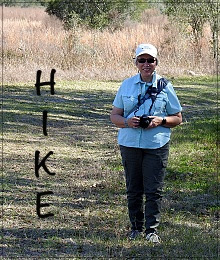We are having so much fun on our hikes this year and hiked on a new trail last weekend.
But first I want to show you what is so pretty in the fields here in North Central Florida right now.

It appears to be a grass and has a pretty red tip on it. Here’s a close up of an individual plant.

But what is it? It’s Dock weed!!!
This is the trail we hiked last weekend. (one of them)
Halpata Tastanaki Preserve
The preserve is named after Seminole leader Hálpata Tastanaki (Chief Alligator).

And I got to see Scrub Jays for the very first time!
According to Wikipedia, “The Florida Scrub Jay is found only in Florida scrub habitat, an ecosystem that exists only in central Florida. The Florida Scrub Jay (Aphelocoma coerulescens[A]) is one of the species of scrub jay native to North America. It is the only species of bird endemic to the U.S. state of Florida and one of only 15 species endemic to the United States. Because of this, it is heavily sought by birders who travel from across the country to observe this unique species.”

They were so beautiful and didn’t seem to mind us being close to them on the trail.
I couldn’t help but think of some captions.

Is she STILL back there?

Just ignore her.

Or give her ‘THE LOOK’!

She’s still there… time to fly!

I’m joining Beautiful Sunday,
Mosaic Monday,
and Amaze me Monday!

Waterlogue effect (IPAD app)
Have you ever seen this red tipped grass in the fields where you live?
Thanks Linda from Wetcreek blog! I think it IS Dock week. Wikipedia has the ID as Rumex crispus HERE. Curly dock, yellow dock or dock week
And it’s found all over North America!
Now we know!
And special thanks to everyone that helped with the ID! You sure are a smart bunch of bloggers!!!







![CoffeeTableIMG_2356[4] CoffeeTableIMG_2356[4]](https://blogger.googleusercontent.com/img/b/R29vZ2xl/AVvXsEi0PGt3C0erM6YCaFoQPgW7Nf2usAUuo0J-kHdLhJHUKhyphenhyphenA-64pCvVsFqSiDeA87e25eHXTnNzENjZ5iEM4eKimDW_ao5TcIlFbvQ81zTnYWeWqMuZRgbhCBF3nIKJ2OQYwto2DQ220yZE/?imgmax=800)

















![RanchIMG_2466[4] RanchIMG_2466[4]](https://blogger.googleusercontent.com/img/b/R29vZ2xl/AVvXsEjjxZib1MS71H6Q-JVeSwlCtPz_QF1YA4nk_XHp1QJaEnyJ9JHfyVqf7OC_LneFVxNPHmevj7gkg5V10EIuiSV0sFdsGul4hs1y_5g9_knbarFCXuQBbVOawtWr6HadEglrq8IWKztaVtdu/?imgmax=800)
![rainbow2IMG_0467[4] rainbow2IMG_0467[4]](https://blogger.googleusercontent.com/img/b/R29vZ2xl/AVvXsEj8UAvUKPb9rE3zwk-dg2CCxuOAhVMi1By897js1uEM8AVQDvSY_RCg_783jAbhYTSq-PMxwBVhTZbbS6w3_O4XotM3itMeKEiwVXP_rmYZWoBLY9ccWZauk17cjl_zosMRctwO97hBA1M/?imgmax=800)
![frameDSCN9793[4][3] frameDSCN9793[4][3]](https://blogger.googleusercontent.com/img/b/R29vZ2xl/AVvXsEgFjxQ5vo3ssriHEykjvnBJwgRxRxi-qkYb17EXTQzHR1Ae9ZIQQnyg3vJftJ6bewxEW3_ZybFev_lgF3RjfJPp_QDyQ0JEnB4ecFxtzERfmnETrZdeReHeYvVPdT6GEVsEGVTN8CGPg_QB/?imgmax=800)































































